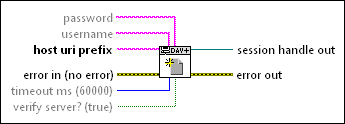 |
password is the password for the WebDAV server, if required. For example, when connecting to a real-time target, use the same password as when connecting with NI Web-based Configuration & Monitoring.
|
 |
username is the username with which to access the WebDAV server, if required. For example, when connecting to a real-time target, use the same username as when connecting with NI Web-based Configuration & Monitoring.
|
 |
host uri prefix specifies the root uniform resource indicator (URI) and an optional prefix for all relative URIs of the file(s) on the host or the target running the WebDAV server. A URI can be a uniform resource locator (URL), a uniform resource name (URN), or both. host uri prefix also specifies the port and whether to use TLS/SSL.
Format host uri prefix as http[s]://hostname[:port][/files]. Use https to connect using Transport Layer Security (TLS), formerly known as Secure Sockets Layer (SSL), which provides added security. Use http to specify a non-TLS/SSL connection. If you do not specify a port number, the default is to use 80 for non-TLS/SSL and 443 for TLS/SSL. On LabVIEW Real-Time targets, you must specify /files as the prefix.
|
 |
error in describes error conditions that occur before this node runs. This input provides standard error in functionality.
|
 |
timeout ms specifies the time, in milliseconds, that the VI waits when another VI makes a request on the same session handle before it returns an error. This timeout value applies to any VI that uses the session. The default is 60,000 ms, or 1 minute. A value of –1 indicates to wait indefinitely.
|
 |
verify server? specifies whether to check the certificate of the server against the list of trusted CA certificates specified by CA certificate file. If you do not specify a list of trusted CA certificates, LabVIEW checks the server's certificate against a default list of trusted CA certificates. If TRUE, the VI verifies the identity of the server using the list of trusted CA certificates for optimal security. If FALSE, the VI does not verify the identity of the server and does not provide optimal security. However, this allows the client to accept self-signed certificates signed by the certificate creator rather than a trusted CA. The default is TRUE.
|
 |
session handle out returns the unique reference to the WebDAV session.
|
 |
error out contains error information. This output provides standard error out functionality.
|

 Add to the block diagram
Add to the block diagram Find on the palette
Find on the palette




